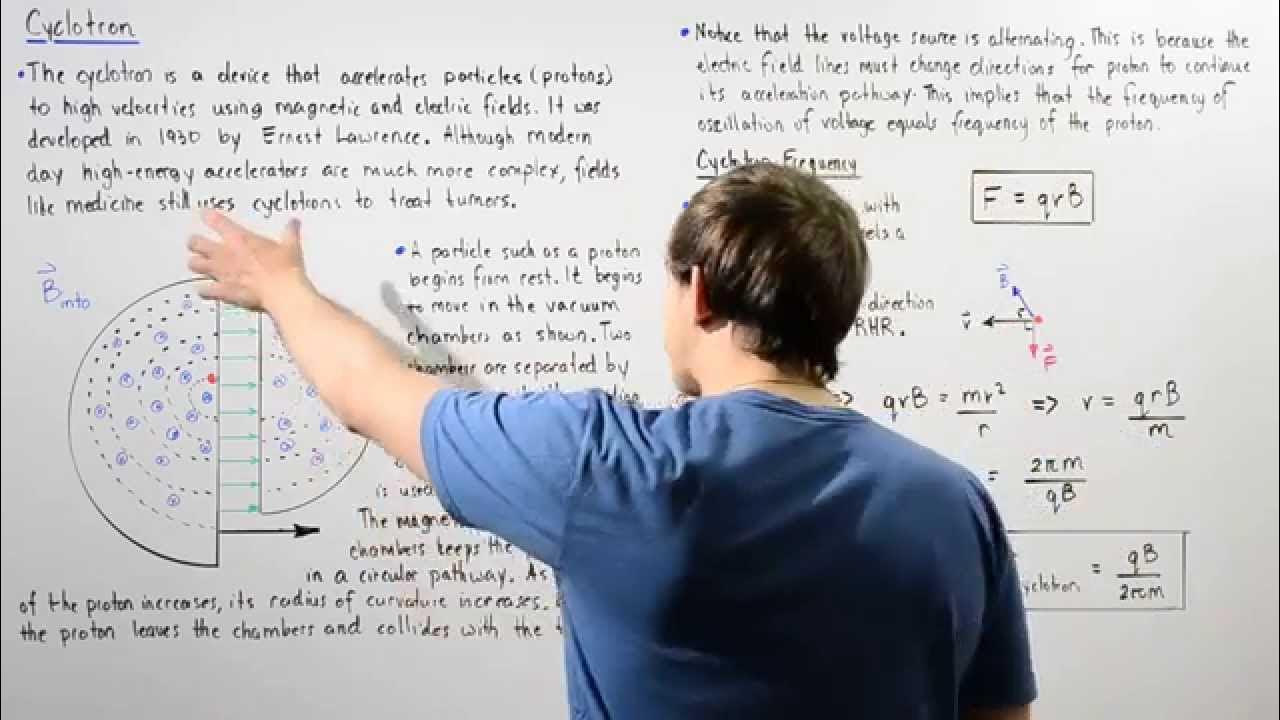Cyclotron | class 12 physics | working principle and construction | cyclotron accelerator
Summary
TLDRThe script introduces the cyclotron, a device with two semicircular metal 'dees' that accelerates particles using an alternating electric field and a perpendicular magnetic field. Protons or other positively charged particles are accelerated in a spiral path, gaining velocity with each pass through the dees, until they reach the periphery for experimental purposes. The key to its operation is synchronizing the high-frequency oscillator's frequency with the particle's revolution frequency, ensuring continuous acceleration without increasing the revolution period.
Takeaways
- 🔧 A cyclotron is composed of two semicircular metal boxes called dees with a small gap between them.
- 🔌 The dees are connected to a high tension oscillator, creating an alternating potential for particle acceleration.
- 💨 The cyclotron is enclosed in an insulated metal box with low-pressure gas to facilitate particle movement.
- 🧲 The apparatus is positioned between strong electromagnets to generate a perpendicular magnetic field to the dees' plane.
- ⚡ The initial stage involves a positively charged particle being accelerated by the negatively charged dee.
- 🌀 Inside the dee, the particle is influenced solely by the magnetic field and its pre-acquired velocity, causing it to turn in a circular path.
- 🔄 The high tension oscillator changes the polarity of the dees to provide a favorable electric field for further acceleration of the particle.
- 🔁 The particle's velocity increases with each pass between dees, resulting in a larger radius of its circular path due to the dependency on velocity.
- 🔄 The frequency of the high tension oscillator must match the particle's revolution frequency for continuous acceleration.
- ⏳ The time period of the particle's revolution is independent of the radius, contrary to what might be expected.
- 🚀 The particle eventually reaches the periphery of the dees, where it is deflected by a negative electrode onto a target for bombardment.
Q & A
What is a cyclotron and what are its main components?
-A cyclotron is a type of particle accelerator that consists of two flat semicircular metal boxes called dees, a high tension oscillator, an insulated metal box containing low-pressure gas, and strong electromagnets providing a magnetic field perpendicular to the dees' plane.
How is the high-frequency alternating potential created in a cyclotron?
-The high-frequency alternating potential is created by connecting the dees to the terminals of a high tension oscillator, which generates several million cycles per second between the dees.
What role does the magnetic field play in the operation of a cyclotron?
-The magnetic field, provided by the electromagnets, acts perpendicular to the plane of the dees and influences the trajectory of the charged particles, causing them to move in a circular path.
Why is the gas inside the cyclotron's metal box kept at low pressure?
-The low-pressure gas inside the insulated metal box reduces air resistance, allowing the accelerated particles to move more freely and maintain their velocity within the cyclotron.
How does a positive particle gain velocity inside a cyclotron?
-A positive particle gains velocity by being accelerated by the electric field of a dee that is at a negative potential at that moment, and then entering another dee where the electric field is zero but the particle retains its velocity due to its momentum.
What is the significance of the dees' polarity changing in the cyclotron?
-The polarity change of the dees, facilitated by the high tension oscillator, provides a favorable electric field that accelerates the positive particle each time it moves from one dee to another.
How does the radius of a particle's circular path relate to its velocity?
-The radius of a particle's circular path is dependent on its velocity. According to the equation of the radius of a circular turn, an increase in velocity results in an increase in the radius.
Why is it crucial for the frequency of the high tension oscillator to match the frequency of the particle's revolution within the dee?
-Matching the frequency ensures that whenever the charged particle is in the gap between the dees, the electric field is aligned with the particle's velocity, allowing for continuous acceleration.
How does the time period of a particle's revolution relate to the radius of its circular path?
-Contrary to what one might expect, the time period of a particle's revolution in a cyclotron is independent of the radius of its circular path due to the specific dynamics of the cyclotron's operation.
What happens to the accelerated particle when it reaches the periphery of the dees?
-Upon reaching the periphery of the dees, the accelerated particle is deflected by an auxiliary negative electrode onto the target to be bombarded.
What is the role of the auxiliary negative electrode in a cyclotron?
-The auxiliary negative electrode is used to deflect the accelerated particle to the target at the periphery of the dees, allowing for the particle to be directed towards its intended point of impact.
Outlines

Этот раздел доступен только подписчикам платных тарифов. Пожалуйста, перейдите на платный тариф для доступа.
Перейти на платный тарифMindmap

Этот раздел доступен только подписчикам платных тарифов. Пожалуйста, перейдите на платный тариф для доступа.
Перейти на платный тарифKeywords

Этот раздел доступен только подписчикам платных тарифов. Пожалуйста, перейдите на платный тариф для доступа.
Перейти на платный тарифHighlights

Этот раздел доступен только подписчикам платных тарифов. Пожалуйста, перейдите на платный тариф для доступа.
Перейти на платный тарифTranscripts

Этот раздел доступен только подписчикам платных тарифов. Пожалуйста, перейдите на платный тариф для доступа.
Перейти на платный тариф5.0 / 5 (0 votes)






